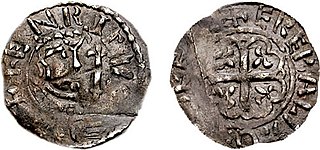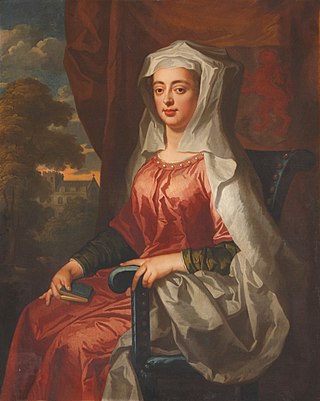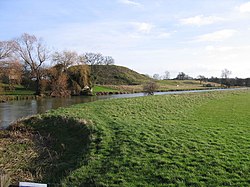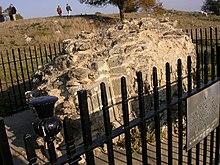
Mary, Queen of Scots, also known as Mary Stuart or Mary I of Scotland, was Queen of Scotland from 14 December 1542 until her forced abdication in 1567.

Fotheringhay is a village and civil parish in North Northamptonshire, England. It is 4 miles (6.4 km) north-east of Oundle and around 13 miles (21 km) west of Peterborough. It is most noted for being the site of Fotheringhay Castle which was razed in 1627. There is nothing left of the castle to be seen today other than the motte on which it was built that provides excellent views of the River Nene. The Nene Way long distance footpath runs through the village.

Thomas Howard, 2nd Duke of Norfolk, styled Earl of Surrey from 1483 to 1485 and again from 1489 to 1514, was an English nobleman, soldier and statesman who served four monarchs. He was the eldest son of John Howard, 1st Duke of Norfolk, by his first wife, Catharina de Moleyns. The Duke was the grandfather of both Queen Anne Boleyn and Queen Katherine Howard and the great-grandfather of Queen Elizabeth I. In 1513, he led the English to victory over the Scots at the decisive Battle of Flodden, for which he was richly rewarded by King Henry VIII, then away in France.

The House of Stuart, originally spelled Stewart, was a royal house of Scotland, England, Ireland and later Great Britain. The family name comes from the office of High Steward of Scotland, which had been held by the family progenitor Walter fitz Alan. The name Stewart and variations had become established as a family name by the time of his grandson Walter Stewart. The first monarch of the Stewart line was Robert II, whose male-line descendants were kings and queens in Scotland from 1371, and of England, Ireland and Great Britain from 1603, until 1714. Mary, Queen of Scots, was brought up in France where she adopted the French spelling of the name Stuart.

The Earldom of Chester was one of the most powerful earldoms in medieval England, extending principally over the counties of Cheshire and Flintshire. Since 1301 the title has generally been granted to heirs apparent to the English throne, and after 1707 the British throne. From the late 14th century, it has been given only in conjunction with that of Prince of Wales.

Earl of Huntingdon is a title which has been created several times in the Peerage of England. The medieval title was associated with the ruling house of Scotland.
Edmund, 1st Earl of Lancaster, also known by his epithet Edmund Crouchback, was a member of the royal Plantagenet Dynasty and the founder of the first House of Lancaster. He was Earl of Leicester (1265–1296), Lancaster (1267–1296) and Derby (1269–1296) in England, and Count Palatine of Champagne (1276–1284) in France.
Maud, Countess of Huntingdon, or Matilda, was Queen of Scotland as the wife of King David I. She was the great-niece of William the Conqueror and the granddaughter of Earl Siward.

Henry Hastings, 3rd Earl of Huntingdon, KG, KB was an English Puritan nobleman. Educated alongside the future Edward VI, he was briefly imprisoned by Mary I, and later considered by some as a potential successor to Elizabeth I. He hotly opposed the scheme to marry Mary, Queen of Scots, to the Duke of Norfolk, and was entrusted by Elizabeth to see that the Scottish queen did not escape at the time of the threatened uprising in 1569. He served as President of the Council of the North from 1572 until his death in 1595.

Sandal Castle is a ruined medieval castle in Sandal Magna, a suburb of the city of Wakefield in West Yorkshire, England, overlooking the River Calder. It was the site of royal intrigue and the setting for a scene in one of William Shakespeare's plays.

The House of Plantagenet was a royal house which originated in the French County of Anjou. The name Plantagenet is used by modern historians to identify four distinct royal houses: the Angevins, who were also Counts of Anjou; the main line of the Plantagenets following the loss of Anjou; and the houses of Lancaster and York, the Plantagenets' two cadet branches. The family held the English throne from 1154, with the accession of Henry II, until 1485, when Richard III died.

Tutbury Castle is a largely ruined medieval castle at Tutbury, Staffordshire, England, in the ownership of the Duchy of Lancaster and hence currently of King Charles III. It is a Scheduled Ancient Monument. People who have stayed in the castle include Eleanor of Aquitaine and Mary, Queen of Scots, who was a prisoner there.

Pleshey is a historic village and civil parish in the Chelmsford district, in the county of Essex, England, 6 miles (10 km) north-west of Chelmsford. The Normans built a motte and bailey in the late 11th century; the motte is one of the largest of its kind in Great Britain. It was besieged several times during the Barons' Wars and rebellions in the 13th century.

Henry of Scotland was heir apparent to the Kingdom of Alba. He was also the 3rd Earl of Northumbria and the 3rd Earl of Huntingdon. He was the son of King David I of Scotland and Queen Maud, 2nd Countess of Huntingdon.

Tibbers Castle is a motte-and-bailey castle overlooking a ford across the River Nith in Dumfries and Galloway, Scotland. To the east is the village of Carronbridge and to the north west is a 16th-century country house, Drumlanrig Castle.

Skipsea Castle was a Norman motte and bailey castle near the village of Skipsea, East Riding of Yorkshire, England. Built around 1086 by Drogo de la Beuvrière, apparently on the remains of an Iron Age mound, it was designed to secure the newly conquered region, defend against any potential Danish invasion and control the trade route across the region leading to the North Sea. The motte and the bailey were separated by Skipsea Mere, an artificial lake that was linked to the sea during the medieval period via a navigable channel. The village of Skipsea grew up beside the castle church, and the fortified town of Skipsea Brough was built alongside the castle around 1160 to capitalise on the potential trade.
Simon I de Senlis, 1st Earl of Northampton and 2nd Earl of Huntingdonjure uxoris was a Norman nobleman.

Warkworth Castle is a ruined medieval castle in Warkworth in the English county of Northumberland. The village and castle occupy a loop of the River Coquet, less than a mile from England's north-east coast. When the castle was founded is uncertain: traditionally its construction has been ascribed to Prince Henry of Scotland, Earl of Northumbria, in the mid-12th century, but it may have been built by King Henry II of England when he took control of England's northern counties. Warkworth Castle was first documented in a charter of 1157–1164 when Henry II granted it to Roger fitz Richard. The timber castle was considered "feeble", and was left undefended when the Scots invaded in 1173.

Buittle Castle, also known historically as Botle or Botel Castle, is a Motte and Bailey site in Galloway, south-west Scotland with significant early and medieval history comprising a significant ruined Norman style Motte, and several extant buildings and gardens, including the later residential building in the form of the Tower House, on the historic Bailey. It is located in the valley of the River Urr, 1 kilometre (0.62 mi) west of Dalbeattie. The castle is within the parish of Buittle, in the traditional county of Kirkcudbrightshire and is a scheduled ancient monument.
Geoffrey de Neville was an English nobleman who served as King's Chamberlain and Seneschal of Gascony and Périgord.



















